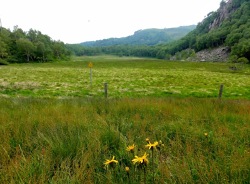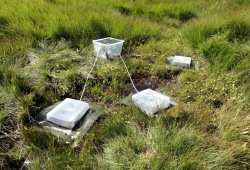A new study that was carried out at Eawag in cooperation with four other research institutes shows that the rates in which gaseous selenium, sulfur and arsenic are released from an alpine peat bog are considerable.
Background:
Natural wetlands cover more than 6% of the global ice-free land area and are well-known for their large contribution to global methane emissions via
biological processes but until now it has not been investigated if wetlands could
also be important emitters of trace elements. Element emissions via biomethylation and subsequent volatilization from pristine wetlands are virtually unstudied, even though wetlands constitute large reservoirs for trace elements and biomethylation is an important biogeochemical process in carbon-rich environments such as wetlands. In the terrestrial environment, quantification of volatilization has almost exclusively been done in contaminated environments such as waste deposits or mining-impacted areas.
The new study:
A new study that was carried out
at Eawag in cooperation with four other research institutes shows that the
rates in which gaseous selenium, sulfur and arsenic are released from an alpine
peat bog are considerable.

|

Experiment site on Gola di Lago
close to Lugano, (Copyright: Eawag)
|
The emission of the vital nutrient selenium seems
especially efficient as it was found to be 40 times more efficiently volatilized
than arsenic, and 100 times more efficiently volatilized than sulfur.
Since in
absolute numbers the released amounts of these elements are small - for selenium
the emitted amounts are on average 0.1 microgram per square meter and day - no danger
for the local population exists. Still, the research project in the hills above
Lugano shows: these atmospheric emissions of trace elements are far from
negligible and the temperature-dependent release rates are expected to rise as
a consequence of global warming. The released trace elements can potentially be
transported away from the peat bog and taken up by plants and organisms somewhere
else. In this way emissions of trace elements from wetlands can eventually
change the distribution of these elements in the environment. Such redistribution
could have important consequences for dietary selenium availability as globally
up to 1 billion people have been estimated to be deficient in selenium.
Source: (adapted from) Andri Bryner, Eawag
 The original paper:
The original paper:
Bas Vriens,
Markus Lenz, Laurent Charlet, Michael Berg, Lenny H.E.
Winkel:
Natural wetland emissions of methylated trace elements; Nature Communications, 5 (2014) #3035. DOI:
10.1038/ncomms4035 Related studies (newest first):
Related studies (newest first):  Adrien Mestrot
Adrien Mestrot,
Britta Planer-Friedrich,
Jörg Feldmann,
Biovolatilisation: a poorly studied pathway of the arsenic biogeochemical cycle, Environ. Sci.: Processes Impacts, 15 (2013) 1639-1651.
DOI: 10.1039/c3em00105a
Hai Huang, Yan Jia, Guo-Xin Sun, Yong-Guan Zhu,
Arsenic Speciation and Volatilization from Flooded Paddy Soils Amended with Different Organic Matters, Environ. Sci. Technol. 2012, 46, 2163-2168.
DOI: 10.1021/es203635s Adrien Mestrot
Adrien Mestrot,
Joerg Feldmann,
Eva M. Krupp, Mahmud S. Hossain, Gabriela Roman-Ross, Andrew A. Meharg,
Field Fluxes and Speciation of Arsines Emanating from Soils, Environ. Sci. Technol., 45 (2011) 1798–1804.
DOI: 10.1021/es103463d
Xi-Xiang Yin, Jian Chen, Jie Qin, Guo-Xin Sun, Barry P. Rosen, Yong-Guan Zhu,
Biotransformation and Volatilization of Arsenic by Three Photosynthetic Cyanobacteria, Plant Physiol., 156 (2011) 1631–1638.
DOI: 10.1104/pp.111.178947
Ronit Jakob, Anja Roth, Karsten Haas,
Eva M. Krupp, Andrea Raab,
Patricia Smichowski, Darío Gómez,
Jörg Feldmann,
Atmospheric stability of arsines and the determination of their oxidative products in atmospheric aerosols (PM10): evidence of the widespread phenomena of biovolatilization of arsenic, J. Environ. Monit., 12 (2010) 409–416.
DOI: 10.1039/b915867g
Jörg Meyer, Klaus Michalke, Theresa Kouril, Reinhard Hensel,
Volatilisation of metals and metalloids: An inherent feature of methanoarchaea?, System. Appl. Microbiol., 31 (2008) 81–87.
DOI: 10.1016/j.syapm.2008.02.001 
G.S. Bañuelos, Z.-Q. Lin,
Acceleration of selenium volatilization in seleniferous agricultural drainage sediments amended with methionine and casein, Environ. Pollution, 150 (2007) 306-312.
DOI: 10.1016/j.envpol.2007.02.009
Jörg Meyer, Annette Schmidt, Klaus Michalke, Reinhard Hensel,
Volatilisation of metals and metalloids by the microbial population of an alluvial soil, System. Appl. Microbiol., (2007) 229–238.
DOI: 10.1016/j.syapm.2006.05.001 B. Planer-Friedrich
B. Planer-Friedrich, Corinne Lehr, Jörg Matschullat, Broder J. Merkel, Darrell Kirk Nordstrom, Mark W. Sandstrom,
Speciation of volatile arsenic at geothermal features in Yellowstone National Park. Geochim. Cosmochim. Acta, 70 (2006) 2480–2491.
DOI: 10.1016/j.gca.2006.02.019 
G.S. Bañuelos, Z.-Q. Lin, I. Arroyo, N. Terry,
Selenium volatilization in vegetated agricultural drainage sediment from the San Luis Drain, Central California, Chemosphere, 60 (2005) 1203–1213.
DOI: 10.1016/j.chemosphere.2005.02.033
T.G. Chasteen, R. Bentley,
Biomethylation of selenium and tellurium: microorganisms and plants, Chem. Rev., 103 (2003) 1–25.
DOI: 10.1021/cr010210+
Z.Q. Lin, V. Cervinka, I.J. Pickering, A. Zayed, N. Terry,
Managing selenium-contaminated agricultural drainage water by the integrated on-farm drainage management system: role of selenium volatilization, Water Res., 36 (2002) 3150–3160.
DOI: 10.1016/S0043-1354(02)00007-6.
R. Bentley, T.G. Chasteen,
Microbial methylation of metalloids: arsenic, antimony, and bismuth, Microbiol. Mol. Biol. Rev., 66 (2002) 250–271.
DOI: 10.1128/MMBR.66.2.250-271.2002
Y.Q. Zhang, W.T. Frankenberger,
Fate of dimethyldiselenide in soil, J. Environ. Qual., 31 (2002) 1124–1128.
DOI: 10.2134/jeq2002.1124
R. Turpeinen, M. Pantsar-Kallio, T. Kairesalo,
Role of microbes in controlling the speciation of arsenic and production of arsines in contaminated soils, Sci. Total. Environ., 285 (2002) 133–145.
DOI: 10.1016/S0048-9697(01)00903-2
J.S. Thayer,
Review: biological methylation of less-studied elements, Appl. Organomet. Chem., 16 (2002) 677–691.
DOI: 10.1002/aoc.375
Emmanuel Tessier,
David Amouroux, Gwenaël Abril, Emmanuelle Lemaire,
Olivier F.X. Donard,
Formation and volatilisation of alkyl-iodidesand -selenides in macrotidal estuaries,
Biogeochem., 59 (2002) 183-206.
DOI: 10.1023/A:1015550931365 D. Amouroux
D. Amouroux, P.S. Liss, E. Tessier, M. Hamren-Larsson,
O.F.X. Donard,
Role of oceans as biogenic sources of selenium, Earth Planet. Sci. Lett., 189 (2001) 277–283.
DOI: 10.1016/S0012-821X(01)00370-3
Y.Q. Zhang, W.T. Frankenberger,
Formation of dimethylselenonium compounds in soil, Environ. Sci. Technol., 34 (2000) 776–783.
DOI: 10.1021/es990958y
Robert S. Dungan, William T. Frankenberger,
Factors affecting the volatilization of dimethylselenide by Enterobacter cloacae SLD1a-1, Soil Biol. Biochem., 32 (2000) 1353-1358.
DOI: 10.1016/S00380717(00)00044-4
J.F. Stolz, R.S. Oremland,
Bacterial respiration of arsenic and selenium, FEMS Microbiol. Rev., 23 (1999) 615–627.
DOI: 10.1111/j.1574-6976.1999.tb00416.x 
A. Stork, W.A. Jury, W. T. Frankenberger,
Accelerated volatilization rates of selenium from different soils, Biol. Trace Elem. Res., 69 (1999) 217–234.
DOI: 10.1007/BF02783874
Drew Hansen, Peter J. Duda, Adel Zayed, Norman Terry,
Selenium Removal by Constructed Wetlands: Role of Biological Volatilization, Environ. Sci. Technol., 32 (1998) 591-597.
DOI: 10.1021/es970502l
 D. Amouroux
D. Amouroux,
O.F.X. Donard,
Evasion of selenium to the atmosphere via biomethylation processes in the Gironde estuary, France, Mar. Chem., 58 (1997) 173–188.
DOI: 10.1016/S0304-4203(97)00033-9
Y.Q. Zhang, J.N. Moore,
Environmental conditions controlling selenium volatilization from a wetland system, Environ. Sci. Technol., 31 (1997) 511-517.
DOI: 10.1021/es960342y  D. Amouroux
D. Amouroux,
O.F.X. Donard,
Maritime emission of selenium to the atmosphere in eastern Mediterranean seas, Geophys. Res. Lett., 23 (1996) 1777–1780.
DOI: 10.1029/96GL01271
W.T. Frankenberger, U. Karlson,
Volatilization of selenium from a dewatered seleniferous sediment: a field study, J. Ind. Microbiol., 14 (1995) 226–232.
DOI: 10.1007/BF01569932
N. Terry, C. Carlson, T.K. Raab, A.M. Zayed,
Rates of selenium volatilization among crop species, J. Environ. Qual., 21 (1992) 341–344.
DOI: 10.2134/jeq1992.00472425002100030006x
L.C.D. Anderson,
K.W. Bruland,
Biogeochemistry of arsenic in natural waters: the importance of methylated species, Environ. Sci. Technol., 25 (1991) 420–427.
DOI: 10.1021/es00015a007
E.T. Thompson-Eagle, W.T. Frankenberger,
Protein-mediated selenium biomethylation in evaporation pond water, Environ. Toxicol. Chem., 9 (1990) 1453–1462.
doi: 10.1002/etc.5620091204 
U. Karlson, W.T Frankenberger,
Volatilization of selenium from agricultural evaporation pond sediments, Sci. Total Environ., 92 (1990) 41-54.
DOI: 10.1016/0048-9697(90)90320-T

E.T. Thompson-Eagle, W.T. Frankenberger, U. Karlson,
Volatilization of selenium by Alternaria-Alternata, Appl. Environ. Microb., 55 (1989) 1406–1413.
available from PMC
W.T. Frankenberger, U. Karlson,
Environmental factors affecting microbial production of dimethylselenide in a selenium contaminated sediment, Soil Sci. Soc. Am. J., 53 (1989) 1435-1442.
DOI: 10.2136/sssaj1989.03615995005300050022x
R. Zieve, P.J. Peterson,
Volatilization of Selenium from Plants and Soils, Sci. Total Environ., 32 (1984) 197-202.
DOI: 10.1016/0048-9697(84)90131-1
R. Zieve, P.J. Peterson,
Factors influencing the volatilization of selenium from soil, Sci. Total Environ., 19 (1981) 277-284.
DOI: 10.1016/0048-9697(81)90022-X

D.C. Reamer, W.H. Zoller,
Selenium biomethylation products from soil and sewage sludge, Science, 208 (1980) 500–502.
DOI: 10.1126/science.208.4443.500
Y.K. Chau, P.T.S. Wong, B.A. Silverberg, P.L. Luxon, G.A. Bengert,
Methylation of selenium in aquatic environments, Science, 192 (1976) 1130–1131.
DOI: 10.1126/science.192.4244.1130  Related EVISA Resources
Related EVISA Resources Link database: Environmental cycling of selenium
Link database: Environmental cycling of selenium Link database: Environmental cycling of arsenic
Link database: Environmental cycling of arsenic
 Related EVISA News
Related EVISA News
 September 14, 2013: Toxic Methylmercury-Producing Microbes More Widespread Than Realized
September 14, 2013: Toxic Methylmercury-Producing Microbes More Widespread Than Realized  February 15, 2011: Natural dissolved organic matter plays dual role in cycling of mercury
February 15, 2011: Natural dissolved organic matter plays dual role in cycling of mercury  September 17, 2010: Occurrence of monoethylmercury in the Florida Everglades verified
September 17, 2010: Occurrence of monoethylmercury in the Florida Everglades verified  June 14, 2005: Arsenic concentration in groundwater may be affected by bacteria
June 14, 2005: Arsenic concentration in groundwater may be affected by bacterialast time modified: January 18, 2025